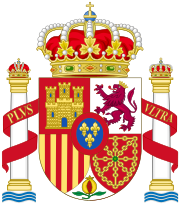Council of Ministers (Spain)
 |
|---|
The Council of Ministers (Spanish: Consejo de Ministros) is a collegiate body composed of the President of the Government (Prime Minister), Vice presidents when existing and the Ministers, and any other member required by law, and in some cases Secretaries of State (Junior Ministers). It is regulated by Article 98 of the Spanish Constitution.
History
Origins
After the experience during the Trienio Liberal[1] the Council of Ministers was formally created by King Ferdinand VII, who ordered by Royal Decree of 19 November 1823 that his Secretaries of State (Secretarios de Estado y del Despacho) should gather to form a body, which was to be called Council of Ministers. In the meetings of this Council all matters of common interest would be discussed, and every Secretary would report about affairs under his responsibility and receive instructions from the King. The Secretary of State would act as Chief Minister and preside over the meetings when the King was absent.[2]
The Council of Ministers under the Constitutional Monarchy
This section is empty. You can help by adding to it. (January 2011) |
The Council of Ministers during the Second Spanish Republic
This section is empty. You can help by adding to it. (January 2011) |
The Council of Ministers during the Franco regime
This section is empty. You can help by adding to it. (January 2011) |
The Council of Ministers in the Spanish Constitution of 1978
The Council of Ministers meets on weekly basis, usually Fridays in the morning at Moncloa Palace, but exceptionally, it may meet in any other city of Spain. The meetings are chaired by the Prime Minister, though, in his absence, Vice presidents take the responsibility to chair over the cabinet. Also on exceptional occasions, the cabinet can be chaired by the King of Spain: in that event the meeting is solely consultative.
See also
Notes
- ^ Villarroya, 25-26
- ^ "Real decreto disponiendo que con los Secretarios de Estado y del Despacho, el de Gracia y Justicia, Guerra, Marina y Hacienda se forme un Consejo que se denominará Consejo de Ministros", Gaceta de Madrid núm. 114 (20/11/1823), p. 423
References
- Villarroya, Joaquín Tomás (1986), Breve historia del constitucionalismo español, Madrid: Centro de Estudios Constitucionales, ISBN 84-259-0652-0.
External links
